Specialties
 Imagine descending below the surface of a clear mountain lake to explore a well-preserved wreck. Interested? Any time you scuba dive at an altitude higher than 300 metres/1000 feet above sea level, you’re altitude diving. If you’re ready to discover a hidden world where few have ventured, then the PADI Altitude Diver Specialty course is for you.
Learning to adjust your dive plan for the reduced surface pressure at altitude is an important part of the course. You’ll complete two scuba dives and learn:
Altitude dive planning, organization, procedures and techniques.
How to adjust your dive computer for altitude diving or calculate altitude dive profiles using the RDP Table or eRDPMLTM.
How to avoid problems and handle emergency situations, if they occur, at altitude.
Prerequisites: PADI (Junior) Open Water Diver (or qualifying entry-level-certification)
Minimum age: 10 years
Imagine descending below the surface of a clear mountain lake to explore a well-preserved wreck. Interested? Any time you scuba dive at an altitude higher than 300 metres/1000 feet above sea level, you’re altitude diving. If you’re ready to discover a hidden world where few have ventured, then the PADI Altitude Diver Specialty course is for you.
Learning to adjust your dive plan for the reduced surface pressure at altitude is an important part of the course. You’ll complete two scuba dives and learn:
Altitude dive planning, organization, procedures and techniques.
How to adjust your dive computer for altitude diving or calculate altitude dive profiles using the RDP Table or eRDPMLTM.
How to avoid problems and handle emergency situations, if they occur, at altitude.
Prerequisites: PADI (Junior) Open Water Diver (or qualifying entry-level-certification)
Minimum age: 10 years During two dives with us, you’ll learn nautical terminology, boat diving etiquette and may practice using lines and/or deploy a surface marker buoy (SMB).
In this course you will learn how to:
Be part of proper boat diving etiquette Understand boat terminology Pack for a boat trip Properly stow your gearYou’ll make two dives from a boat where you’ll practice entering and exiting the water and properly stowing your gear. We will also teach you about local boat diving etiquette and safety procedures.
Prerequisites: PADI (Junior) Open Water Diver (or qualifying entry-level-certification)
Minimum age: 10 years
During two dives with us, you’ll learn nautical terminology, boat diving etiquette and may practice using lines and/or deploy a surface marker buoy (SMB).
In this course you will learn how to:
Be part of proper boat diving etiquette Understand boat terminology Pack for a boat trip Properly stow your gearYou’ll make two dives from a boat where you’ll practice entering and exiting the water and properly stowing your gear. We will also teach you about local boat diving etiquette and safety procedures.
Prerequisites: PADI (Junior) Open Water Diver (or qualifying entry-level-certification)
Minimum age: 10 years During the PADI® Deep Diver course, you’ll learn how to plan deep dives, manage your gas supply and how to identify and manage narcosis.
You’ll learn about buddy contact procedures, safety considerations and buoyancy control at depth. After this course you’ll be able to:
1. Make deep dives without an instructor
2. See more of the underwater world
3. Dive to a maximum depth of 40m/130ft
4. Manage your gas supply
5. Identify and deal with narcosis
6. Recognize your personal limits
During your four dives with a us, you’ll practice descents, buoyancy and safety stops. Through hands-on exercises, you’ll discover how deep dives affect color, physical objects and your brain. Note: the four dives must be completed over a minimum of two days.
Prerequisites: PADI Adventure Diver (or qualifying certification)
Minimum age: 15 years or older
During the PADI® Deep Diver course, you’ll learn how to plan deep dives, manage your gas supply and how to identify and manage narcosis.
You’ll learn about buddy contact procedures, safety considerations and buoyancy control at depth. After this course you’ll be able to:
1. Make deep dives without an instructor
2. See more of the underwater world
3. Dive to a maximum depth of 40m/130ft
4. Manage your gas supply
5. Identify and deal with narcosis
6. Recognize your personal limits
During your four dives with a us, you’ll practice descents, buoyancy and safety stops. Through hands-on exercises, you’ll discover how deep dives affect color, physical objects and your brain. Note: the four dives must be completed over a minimum of two days.
Prerequisites: PADI Adventure Diver (or qualifying certification)
Minimum age: 15 years or older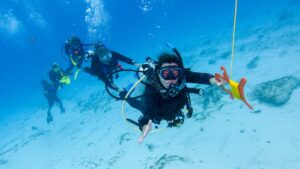 Diving in a current can feel like flying underwater. In the PADI® Drift Diver course, you’ll learn drift diving tips from an experienced instructor and practice buoyancy control, navigation, use of surface signaling equipment and buddy communication.
Scuba diving in a current can be both relaxing and exhilarating. You may slowly glide over a reef, or zoom over an underwater landscape so fast it feels like flying. By the end of your drift diver course, you’ll have the skills you need to confidently go with the flow.
In this course you will learn how to:
Feel confident diving in a current
Learn about aquatic currents – causes and effects
Use surface signaling equipment
Stay close to your buddy
Make entries and descents in a current
During two dives in a current, you’ll practice buoyancy control, navigation and buddy communication. Practice using a delayed surface marker buoy (DSMB), float, line, reel, or other drift diving safety equipment.
Prerequisites: PADI (Junior) Open Water Diver (or qualifying entry-level certification)
Minimum age: 12 years or older
Diving in a current can feel like flying underwater. In the PADI® Drift Diver course, you’ll learn drift diving tips from an experienced instructor and practice buoyancy control, navigation, use of surface signaling equipment and buddy communication.
Scuba diving in a current can be both relaxing and exhilarating. You may slowly glide over a reef, or zoom over an underwater landscape so fast it feels like flying. By the end of your drift diver course, you’ll have the skills you need to confidently go with the flow.
In this course you will learn how to:
Feel confident diving in a current
Learn about aquatic currents – causes and effects
Use surface signaling equipment
Stay close to your buddy
Make entries and descents in a current
During two dives in a current, you’ll practice buoyancy control, navigation and buddy communication. Practice using a delayed surface marker buoy (DSMB), float, line, reel, or other drift diving safety equipment.
Prerequisites: PADI (Junior) Open Water Diver (or qualifying entry-level certification)
Minimum age: 12 years or older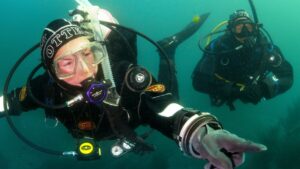 Learn to dive year round by using a Drysuit in cold water. Unlike wetsuits, drysuits are filled with air. During your drysuit course, We will teach you how to control the air in your drysuit along with your buoyancy. You’ll learn how to:
Dive in colder water temperatures
Stay warmer in colder waters
Learn to dive in a drysuit
Buy a drysuit
Avoid common drysuit diving problems
Choose a drysuit and undergarments
Care for your Drysuit
You’ll also learn about different types of drysuits, basic drysuit repairs and maintenance.
During one pool session and two open water dives, you’ll learn how to comfortably and confidently dive in a drysuit. An experienced instructor will help you dial in your buoyancy and shorten the learning curve.
You’ll practice taking your drysuit on and off, determine how much weight you need, and master basic drysuit skills in a pool before making two open water dives.
Prerequisites: PADI (Junior) Open Water Diver (or qualifying entry-level certification)
Minimum age: 10 years or older
Learn to dive year round by using a Drysuit in cold water. Unlike wetsuits, drysuits are filled with air. During your drysuit course, We will teach you how to control the air in your drysuit along with your buoyancy. You’ll learn how to:
Dive in colder water temperatures
Stay warmer in colder waters
Learn to dive in a drysuit
Buy a drysuit
Avoid common drysuit diving problems
Choose a drysuit and undergarments
Care for your Drysuit
You’ll also learn about different types of drysuits, basic drysuit repairs and maintenance.
During one pool session and two open water dives, you’ll learn how to comfortably and confidently dive in a drysuit. An experienced instructor will help you dial in your buoyancy and shorten the learning curve.
You’ll practice taking your drysuit on and off, determine how much weight you need, and master basic drysuit skills in a pool before making two open water dives.
Prerequisites: PADI (Junior) Open Water Diver (or qualifying entry-level certification)
Minimum age: 10 years or older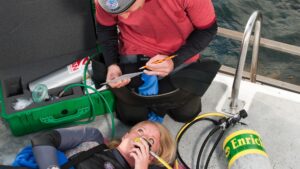 Knowing how and when to use emergency oxygen is a great skill to have and means you’re ready to help others should the need arise. Becoming a PADI Emergency Oxygen Provider lets you breathe easy knowing that you can recognize scuba diving illnesses treatable with emergency oxygen, and are prepared to offer aid.
There are no prerequisites, age restrictions or water sessions required for this course – it’s open to everyone. Scuba divers, snorkelers and anyone who is around divers – boat crew, lifeguards, etc. – will benefit from having this training.
You’ll learn about dive injuries, different types of emergency oxygen equipment and safety considerations when using oxygen. Then you’ll practice:
Assembling and disassembling emergency oxygen equipment.
Deploying a non-rebreather mask and a demand inhalator valve on a breathing diver.
Using a pocket mask on a nonbreathing diver.
Prerequisites: None
Knowing how and when to use emergency oxygen is a great skill to have and means you’re ready to help others should the need arise. Becoming a PADI Emergency Oxygen Provider lets you breathe easy knowing that you can recognize scuba diving illnesses treatable with emergency oxygen, and are prepared to offer aid.
There are no prerequisites, age restrictions or water sessions required for this course – it’s open to everyone. Scuba divers, snorkelers and anyone who is around divers – boat crew, lifeguards, etc. – will benefit from having this training.
You’ll learn about dive injuries, different types of emergency oxygen equipment and safety considerations when using oxygen. Then you’ll practice:
Assembling and disassembling emergency oxygen equipment.
Deploying a non-rebreather mask and a demand inhalator valve on a breathing diver.
Using a pocket mask on a nonbreathing diver.
Prerequisites: None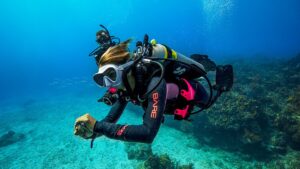 Enriched air, also known as nitrox or EANx, contains less nitrogen than regular air. Breathing less nitrogen means you can enjoy longer dives and shorter surface intervals. No wonder Enriched Air Diver is the most popular PADI® specialty.
After finishing your independent study, you’ll learn how to analyze a tank, fill out an enriched air log, and set your dive computer for nitrox. There is a final exam and two optional dives.
Prerequisites: PADI Open Water Diver (or qualifying certification) Minimum age: 12 years
Enriched air, also known as nitrox or EANx, contains less nitrogen than regular air. Breathing less nitrogen means you can enjoy longer dives and shorter surface intervals. No wonder Enriched Air Diver is the most popular PADI® specialty.
After finishing your independent study, you’ll learn how to analyze a tank, fill out an enriched air log, and set your dive computer for nitrox. There is a final exam and two optional dives.
Prerequisites: PADI Open Water Diver (or qualifying certification) Minimum age: 12 years
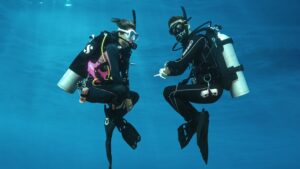 Don’t miss a dive due to minor issues with your scuba diving equipment. Whether it’s a missing o-ring, wetsuit tear or a broken fin strap, the PADI Equipment Specialist course teaches you to manage basic repairs and adjustments. You’ll also learn more about how your gear works, making you more comfortable with it and better prepared to take care of your investment.
In this course you will learn how to:
Make minor gear repairs
Avoid missing dives due to gear issues
Maximize the life of your equipment
Fix equipment problems
Clean and maintain your gear
Create a save-a-dive kit
Get hands-on experience making minor equipment repairs and learn about different types of dive gear. Learn how to properly clean and maintain gear, and how to create a save-a-dive kit.
Prerequisites: PADI (Junior) Scuba Diver (or qualifying entry-level certification)
Minimum age: 10 years
Don’t miss a dive due to minor issues with your scuba diving equipment. Whether it’s a missing o-ring, wetsuit tear or a broken fin strap, the PADI Equipment Specialist course teaches you to manage basic repairs and adjustments. You’ll also learn more about how your gear works, making you more comfortable with it and better prepared to take care of your investment.
In this course you will learn how to:
Make minor gear repairs
Avoid missing dives due to gear issues
Maximize the life of your equipment
Fix equipment problems
Clean and maintain your gear
Create a save-a-dive kit
Get hands-on experience making minor equipment repairs and learn about different types of dive gear. Learn how to properly clean and maintain gear, and how to create a save-a-dive kit.
Prerequisites: PADI (Junior) Scuba Diver (or qualifying entry-level certification)
Minimum age: 10 years Excellent buoyancy control is what defines skilled scuba divers. You’ve seen them underwater. They glide effortlessly, use less air and ascend, descend or hover almost as if by thought. They more easily observe aquatic life without disturbing their surroundings. You can achieve this, too. The PADI Peak Performance Buoyancy Specialty course improves the buoyancy skills you learned as a new diver and elevates them to the next level.
In this course you will learn how to:
Improve your buoyancy control
Dive with less weight
Reduce your air consumption
Achieve neutral buoyancy
Hover effortlessly
Use the right amount of weight for your configuration
Determine how much weight you need and where to place trim weights to streamline your body position. During two dives you’ll fine-tune your weighting during buoyancy checks and master neutral buoyancy with inwater practice.
Prerequisites: PADI (Junior) Open Water Diver (or qualifying entry-level certification)
Minimum age: 10 years
Excellent buoyancy control is what defines skilled scuba divers. You’ve seen them underwater. They glide effortlessly, use less air and ascend, descend or hover almost as if by thought. They more easily observe aquatic life without disturbing their surroundings. You can achieve this, too. The PADI Peak Performance Buoyancy Specialty course improves the buoyancy skills you learned as a new diver and elevates them to the next level.
In this course you will learn how to:
Improve your buoyancy control
Dive with less weight
Reduce your air consumption
Achieve neutral buoyancy
Hover effortlessly
Use the right amount of weight for your configuration
Determine how much weight you need and where to place trim weights to streamline your body position. During two dives you’ll fine-tune your weighting during buoyancy checks and master neutral buoyancy with inwater practice.
Prerequisites: PADI (Junior) Open Water Diver (or qualifying entry-level certification)
Minimum age: 10 years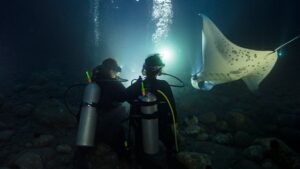 The thought of dipping below the surface at night seems mysterious, yet so alluring. Although you’ve been scuba diving at a site many times before, at night you drop into a whole new world and watch it come to life under the glow of your dive light. The scene changes as day creatures retire and nocturnal organisms emerge. If you’ve wondered what happens underwater after the sun goes down, sign up for the PADI Night Diver Specialty course.
In this course you will learn how to:
Avoid getting lost in the dark
Navigate underwater at night
Make ascents and descents in the dark
Use your dive light for communication
Try something new and exciting! Practice underwater navigation at night and learn how to find entry and exit points in the dark. We will share night diving tips, teach you how to stay in contact with your buddy, and avoid disorientation.
Prerequisites: PADI (Junior) Open Water Diver (or qualifying entry-level certification)
Minimum age: 12 years
The thought of dipping below the surface at night seems mysterious, yet so alluring. Although you’ve been scuba diving at a site many times before, at night you drop into a whole new world and watch it come to life under the glow of your dive light. The scene changes as day creatures retire and nocturnal organisms emerge. If you’ve wondered what happens underwater after the sun goes down, sign up for the PADI Night Diver Specialty course.
In this course you will learn how to:
Avoid getting lost in the dark
Navigate underwater at night
Make ascents and descents in the dark
Use your dive light for communication
Try something new and exciting! Practice underwater navigation at night and learn how to find entry and exit points in the dark. We will share night diving tips, teach you how to stay in contact with your buddy, and avoid disorientation.
Prerequisites: PADI (Junior) Open Water Diver (or qualifying entry-level certification)
Minimum age: 12 years The next time someone loses an item underwater, you can be the hero that finds the missing object.
Finding items underwater is both challenging and rewarding. You need to know how to gather information, organize a search and choose an effective underwater search pattern. Your PADI Instructor will give you practice scenarios to build and hone your skills.
In the PADI® Search and Recovery course, you’ll learn how to find lost objects underwater. You’ll practice different types of underwater search patterns and learn how to use a lift bag as you plan and execute mock search operations.
In this course you will learn how to:
Recover lost items
Execute underwater search patterns
Improve your navigation skills
Find things underwater
Use a lift bag
Plan a search operation
During four dives over at least 2 days, you’ll locate objects large and small using different search patterns. You’ll get hands-on experience using a lift bag and, on the last dive, you’ll plan and execute a mock search operation.
Prerequisites: PADI (Junior) Advanced Open Water Diver
Minimum age: 12 years
The next time someone loses an item underwater, you can be the hero that finds the missing object.
Finding items underwater is both challenging and rewarding. You need to know how to gather information, organize a search and choose an effective underwater search pattern. Your PADI Instructor will give you practice scenarios to build and hone your skills.
In the PADI® Search and Recovery course, you’ll learn how to find lost objects underwater. You’ll practice different types of underwater search patterns and learn how to use a lift bag as you plan and execute mock search operations.
In this course you will learn how to:
Recover lost items
Execute underwater search patterns
Improve your navigation skills
Find things underwater
Use a lift bag
Plan a search operation
During four dives over at least 2 days, you’ll locate objects large and small using different search patterns. You’ll get hands-on experience using a lift bag and, on the last dive, you’ll plan and execute a mock search operation.
Prerequisites: PADI (Junior) Advanced Open Water Diver
Minimum age: 12 years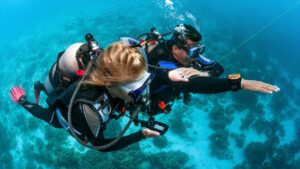 Be the scuba diver everyone wants to follow because you know where you are and where you’re going. The PADI Underwater Navigator course fine-tunes your observation skills and teaches you to more accurately use your compass underwater. If you like challenges with big rewards, take this course and have fun finding your way.
If you’re a PADI (Junior) Open Water Diver who is at least 10 years old, you can enroll in the PADI Underwater Navigator Specialty course.
It’s easy to get disoriented underwater if you don’t know how to use a compass or natural navigation clues. Learn how to easily find your way back to boat or shore without returning to the surface and avoid long, exhausting swims. This course will help you:
Improve your navigation skills
Polish techniques for finding the boat without surfacing
Learn natural navigation clues
Better use a diving compass
Navigate making multiple turns
Estimate distance underwater
Practice using a compass on the surface, then apply your skills underwater during three dives. Learn how to estimate distance, follow natural clues and practice finding your way back to the boat or shore.
Prerequisites: PADI (Junior) Open Water Diver (or qualifying entry-level certification)
Minimum age: 10 years
Be the scuba diver everyone wants to follow because you know where you are and where you’re going. The PADI Underwater Navigator course fine-tunes your observation skills and teaches you to more accurately use your compass underwater. If you like challenges with big rewards, take this course and have fun finding your way.
If you’re a PADI (Junior) Open Water Diver who is at least 10 years old, you can enroll in the PADI Underwater Navigator Specialty course.
It’s easy to get disoriented underwater if you don’t know how to use a compass or natural navigation clues. Learn how to easily find your way back to boat or shore without returning to the surface and avoid long, exhausting swims. This course will help you:
Improve your navigation skills
Polish techniques for finding the boat without surfacing
Learn natural navigation clues
Better use a diving compass
Navigate making multiple turns
Estimate distance underwater
Practice using a compass on the surface, then apply your skills underwater during three dives. Learn how to estimate distance, follow natural clues and practice finding your way back to the boat or shore.
Prerequisites: PADI (Junior) Open Water Diver (or qualifying entry-level certification)
Minimum age: 10 years
 Whether purpose-sunk as an artificial reef for scuba divers, or lost as the result of an accident, wrecks are fascinating windows to the past. Ships, airplanes and even cars are fascinating to explore and usually teem with aquatic life. Each wreck dive offers a chance for discovery, potentially unlocking a mystery or spying something others have missed. The PADI Wreck Diver Specialty course is popular because it offers rewarding adventures while observing responsible wreck diving practices.
During this course you will learn how to:
Explore inside wrecks
Accomplish special finning techniques
Survey a wreck
Use lines and reels
Avoid common problems
During four dives over a minimum of 2 days, you’ll survey and map a wreck, practice special finning techniques and may use penetration lines.
Prerequisites: PADI Adventure Diver (or qualifying certification)
Minimum age: 15 years
Whether purpose-sunk as an artificial reef for scuba divers, or lost as the result of an accident, wrecks are fascinating windows to the past. Ships, airplanes and even cars are fascinating to explore and usually teem with aquatic life. Each wreck dive offers a chance for discovery, potentially unlocking a mystery or spying something others have missed. The PADI Wreck Diver Specialty course is popular because it offers rewarding adventures while observing responsible wreck diving practices.
During this course you will learn how to:
Explore inside wrecks
Accomplish special finning techniques
Survey a wreck
Use lines and reels
Avoid common problems
During four dives over a minimum of 2 days, you’ll survey and map a wreck, practice special finning techniques and may use penetration lines.
Prerequisites: PADI Adventure Diver (or qualifying certification)
Minimum age: 15 yearsIf you are looking to dive below the surface at night, sign up for the PADI Night Diver Specialty course at Adventure Scuba, LLC. You will learn light handling and communication techniques, entering, exiting, and navigating in the dark.
If you want to scuba dive with confidence at depths down to 130 feet, consider the PADI Deep Diver Specialty course. During the course of two days, you will learn about specialized deep diving equipment, deep dive planning, contact procedures, and buoyancy control.
Enroll in the PADI Underwater Navigator course to fine-tunes your observation skills and how to be more accurately using your compass underwater.
Consider the PADI Peak Performance Buoyancy Specialty course to increase the buoyancy skills and elevate them to the next level. During the course, candidates will learn how to determine the exact weight they need, so that they are not too light or too heavy, trim their weight system, among others.
If you want to be skilled in finding things lost in the water, then the Search and Recovery Diver Specialty course is for you. During the course, you will learn swimming search patterns using the compass and natural navigation.
Consider the PADI Drift Diver Specialty course, if you want to learn how to use ocean currents to glide along during your dive. While it can be relaxing and exhilarating, you will know drift diving techniques and procedures, and get an introduction to drift diving equipment – floats, lines, and reels.
If you want to know how to use emergency oxygen, consider becoming a PADI Emergency Oxygen Provider. You will learn about dive injuries, types of emergency oxygen equipment, and safety considerations. Also, you will know how to assemble and disassemble emergency oxygen equipment, deploy a non-rebreather and use a pocket mask on a nonbreathing diver.
If you have never attempted a boat dive, consider the PADI Boat Diver Specialty course as it will expand your knowledge about boats from small inflatables to large liveaboards. You will learn how to enter and exit and where to stow your gear, boating safety, and how to locate safety equipment.
